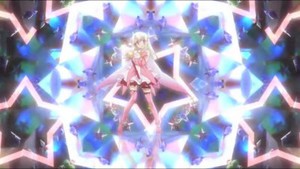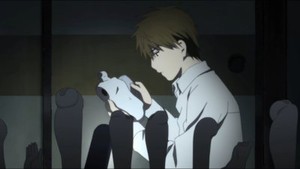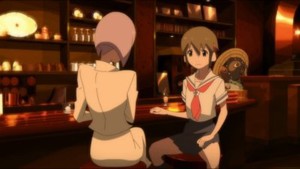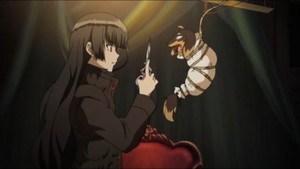The Summer 2013 Anime Preview Guide
Rebecca Silverman
Rebecca Silverman lives atop a lupine covered hill overlooking the sea, but it's less like a Miyazaki film than it sounds: the field is also full of ticks and the sea is a working harbor. Rebecca is an enthusiastic reader of pretty much everything and shares her home with more books than can be reasonably counted, along with five cats and a dog. She has a special love for shoujo from the 1970s and 1980s, magical girls, and mysteries, and her major anime and manga pet peeve is when all male servants are labeled "butlers" when they should be "valets" or "stewards." Currently she is helping her local library to start a manga section and getting local kids to read something that isn't Pokemon.

Hyperdimension Neptunia
Rating: 1 (out of 5)
Review:
Based on the game franchise of the same name, Hyperdimension Neptunia takes place in a world where all of the major game consoles (pre-E3) are personified as cute girls who can transform into busty lightly-clad ladies. Previously they were at war, but now the group has called a truce, vowing to support each other and to share Shares, the source of their power. As the title sort of suggests, the main character that we follow is Neptune (a reference to a canceled Sega system), who is known as Purple Heart in her other incarnation. She is the goddess (written in the subtitles as “CPU”) of Planeptune, and she's not very good at her job. When she and her little sister Nepgear learn that some of their subjects aren't happy with them, Neptune informs the fairy Histoire that she's going to go to goddess school. Histoire is dubious, and the fact that Neptune plans to learn from her neighbor Noire over in Lastation (PlayStation) doesn't really help. Noire does her best, but her attempts to get Neptune some battle experience just end up with Neptune and Nepgear getting molested by dogoos, little blue blobs with dog ears. Towards the end of the episode Neptune does prove herself to be somewhat capable, but what really saves the day are the prurient pictures that Noire's little sister Uni takes during the battle. As a bonus, the next episode has a title involving the word “lick.”
This introductory episode is a combination of “confusing” and “not that interesting.” The idea of the world is fun, if not a little silly and contrived, and I like the way the series looks, particularly the Sisters Nep, with their direction pad hair clips and pleasant purple color scheme. But the way the plot is played out feels like an attempt at humor while pandering. Neither of these things are objectively awful and can both be used well, but neither of them really are in this case. Having the girls get molested by the dogoos feels frankly icky, and the way that Vert (Xbox)'s breasts appear to bounce spontaneously while she's sitting around is weird, at least from the perspective of someone who doesn't find breasts fascinating. The plot of the episode is very thin and not terribly well executed, and the closing joke just feels mean. The fact that everyone seems to have a little sister is also an odd note – are there any men at all in this story, or does it take place on some game-based Sapphic paradise?
I have a suspicion that the original games may be a better way to experience Hyperdimension Neptunia. The anime version is definitely lacking in terms of story and execution, although it does look pretty for the most part. Watch it to assuage your curiosity or for a brainless half hour, but if you're looking for more substance with your cute girls, try a different show.
Hyperdimension Neptunia is available streaming at Funimation.
 Fate/kaleid liner PRISMA ILLYA
Fate/kaleid liner PRISMA ILLYA
Rating: 2.5 (out of 5)
Review:
Illya is an elementary school student living with a foster family, at least two of whom, Mom and sister Liz, look suspiciously like her. She's happy, perky, fond of magical girl anime, and has a crush on her foster brother Shiro. Rin and Luvia are older girls who have been sent to Japan by their mysterious Master on some sort of quest. They're also magical girls who have “registered” with the magic sticks Ruby and Sapphire. Unfortunately Rin and Luvia also hate each other, so Ruby and Sapphire decide to cancel their registration and find new girls to contract with. If this leaves untransformed Rin and Luvia in the air miles above the ground, oh well. Life sucks, moving on to find new girls.
Having left Rin to her fate, Ruby flies into Illya's bathroom while she's in the tub and tries to get her to become a magical girl. Illya's apparently seen Puella Magi Madoka Magica, because she thinks the whole thing sounds fishy. Sadly for her, Ruby's even less scrupulous than Kyubey, and before Illya knows what's going on, she's a magical girl. Whoops. At least she's not naked anymore.
The latest anime series inspired by Type Moon's Fate/Stay Night, Fate/kaleid liner Prisma Illya is definitely not a magical girl show for little girls. It wobbles between being a tongue-in-cheek commentary on the genre and being loli fanservice, and both segments are peppered with some slightly off-color jokes. Ruby is quite possibly the worst magical mascot ever – not only does she trick Illya in the first place, but she also narrates her transformation sequence - “That's the angle!”- and comments about how loli magical girls really are the best. She also knocks Shiro unconscious during the obligatory scene where he walks in on Illya in the tub and then lifts up his towel to flash Illya. All of this isn't so great for Illya herself, but it's pretty funny for us.
The new designs for the familiar characters range from cute to kind of odd. Shiro's look in particular is a little too young and perky, but Illya is quite adorable. Rin's face is rounder, but otherwise she looks about the same, and Taiga, who gets a brief appearance, is identical to her F/SN self. Luvia has the most off design, looking just like every other anime girl with blond ringlets and a floofy dress, and both wands appear to have escaped from Card Captor Sakura. Right now the stand out voice is Naoko Takano's Ruby, who sounds like a weird combination of a cute little girl and a dirty old man.
I really struggled to pick a number for this show. On the one hand, it felt kind of awful – Pretty Sammy for the Fate fans. On the other hand, it was kind of funny, and I was equally annoyed and amused by Ruby and Rin's cat-ears in her transformation. I think this is going to be one best experienced personally – be you F/SN fan or magical girl fan, there's a little something that might make you laugh...but you might feel a little silly while watching it.
Fate/kaleid liner PRISMA ILLYA is available streaming at Crunchyroll.
 Danganronpa: The Animation
Danganronpa: The Animation
Rating: 1 (out of 5)
Review:
Stop me if you know this story: a bunch of teenagers are all put into a situation where the only way that they can survive is if they kill their companions. Is it The Hunger Games? Battle Royal? Doubt? No, this story's title is Danganronpa: The Animation and it is an adaptation of the video game of the same name. In this iteration of the teen-on-teen-deathmatch story, there is a special school for those gifted in all areas – fighting, gambling, swimming, fortunetelling, biking...you name it. Sounds a bit like the school from R-15, doesn't it? Well, this time there's a catch. First of all, each year a random “average” student is selected to attend this very special school, and this year his name is Makoto. The next important detail is that school is run by a psychotic teddy bear named Monokuma. Monokuma has a sadistic streak, and the way he runs his academy reflects that: the only way to graduate is to commit murder. No murder, no leaving. Period. Understandably this doesn't go over well with the fifteen students who make up the new class and they decline to immediately go on a killing spree. No worries, Monokuma has a plan for that – he'll show them threatening videos of their families. Who wants to get out now, hmm?
As an introductory episode, not to mention the stated prologue to the main story, Danganronpa's start really throws a lot at you, mostly in terms of characters. All fifteen (sixteen counting the bear) are introduced almost at once, and while some peoples' appearances serve to remind us what they're the best at, for the most part it's just a rogue's gallery of potential murderers/victims. There is little to no explanation offered as to what Monokuma's deal is, what's truly going on, or even how all of these kids got here in the first place. Why did Makoto black out when he set foot on school grounds? How is this school still in operation? No one knows, and for a first episode, that's technically okay – except that we don't even get any hints. My best guess at this point is that it's some sort of purgatory, but that may be in part because Monokuma seems especially satanic. His parti-colored design, with one eye red and shaped like a bat, is disturbing, particularly when contrasted with his otherwise cuddly appearance. The school itself also has an otherworldly look to it, with large iron plates where windows should be, a red color scheme, and an array of deep, bright colors. Regretfully it feels like watching someone else play a game rather than watching a television show; one conversation between hero and love interest even has you waiting for dialog choices.
Danganronpa: The Animation is perhaps not the best example of a game turned into anime. It throws too many characters at you at once, feels contrived in both plot and execution, and just doesn't do enough different with a plot that's been seen/read/played before. The characters are all varied and interesting to look at and the colors are well used, but that's about it. Add to that the fact that I found Monokuma so intensely annoying that I wanted to put my fist through his smug little face and this was probably my least favorite show of the season. You may feel differently if you've played the game, but my suggestion? Go read Doubt (the Yen Press one) instead. It does the story better.
Danganronpa: The Animation is available streaming on Funimation.

Gatchaman Crowds
Rating: 1.5 (out of 5)
Review:
Gatcha-maaaaan!
Now that we've gotten my favorite part of the episode covered, let's look at the rest of it. Sugune a (middle? High school?) student is riding on the train, helping a pregnant woman get a seat, when suddenly his little grey notebook magically flips open and words appear on the page. These direct him to a specific target, a man with no apparent distinguishing features, who is somehow a threat. Meanwhile, his fellow student Hajime is busy kissing her newest notebook. As her classmates remark, she really likes little notebooks. She invites this new one to go outside with her, where she meets JJ, a, uh, space vampire who reaches into her chest and pulls out a notebook like Sugune's. Now Hajime is officially a Gatchaman, a protector of the earth who fights against the alien menaces that appear from time to time!
Throughout the course of what appears to be the shortest full-length episode of the season (only twenty-two minutes), Hajime bops around introducing herself to everyone and annoying Sugune and the viewer about equally. She just loves everything – Utsu-Utsu's swimsuit/underwear, JJ, her notebook, that cute little alien that wants to absorb the people of earth...she's like a sugared up three year old as she runs around. She's also a pretty powerful gatchaman as it turns out, in her adorable pink and white costume with fluffy pigtails. Watching her for too long is sort of like eating too much cotton candy, a sensation that is supported by the psychedelic color scheme that the show employs. The secret headquarters of the Gatchaman Gang is full of crazy patterns and bright colors, everyone's hair has weird darker bands wrapping around at odd angles, to say nothing of small white dots presumably meant to denote shine, and there's something off-putting about Sugune's eyes.
On the whole, Gatchaman Crowds just feels like it's moving at warp speed through the episode. Hajime's unrelenting cheer and supposedly cute quirks are grating, and, well, it just doesn't make huge amounts of sense while at the same time having a perfectly clear plot. That's a difficult way to put it, I know, but that's what it feels like when watching. If you're a gatchaman devotee or have a higher tolerance for Hajime as a character type (she reminds me of Tamaki from Majestic Prince), then you'll likely get more enjoyment out of this than I did. For me, however, it was just too much while simultaneously not being enough.
Gatchaman Crowds is available streaming on Crunchyroll.

Rozen Maiden Zurückspulen episode 2
Rating: 3 (out of 5)
Review:
Down another leg in the trousers of time (if I may borrow Terry Pratchett's metaphor), middle school student Jun Sakurada did not choose to wind a Rozen Maiden. Now he is a college student (although he never went to high school) working part time at a book store and leading a miserable existence. Deep down he knows that something is not right, but it is difficult to tell if this is his general dissatisfaction with life or because this was not the world he was meant to live in. One day in the storage room of the book store he finds a box that has been returned; it contains the first issue of a magazine bizarrely titled “How to Make Girls Weekly” and claims that it will enable the reader to build his own Rozen Maiden doll, with parts in each issue. Before long Jun finds the magazine coming to his door and himself growing obsessed with building Rozen Maiden number 5, Shinku. Then he starts to get texts from his middle school self about an alternate world where he chose to wind a doll...
Apart from the fact that Jun needs to check his microwave, this second episode of Rozen Maiden Zurückspulen is a definite improvement on the first, and not just because it covers new territory at a more reasonable pace. Adult Jun may feel very sorry for himself, but he can also be easily hurt by the remarks of others, which makes him more relateable than he might otherwise be. He's clearly trying to live in the world, but his social anxiety makes it an uphill battle. His cute co-worker Saito tries to befriend him and he tries to interact with her, but he's obviously uncomfortable. Somehow this makes Jun an easier character to get behind than when he was simply surrounded by super-powered ball-jointed dolls.
Speaking of dolls, people who are afraid of them will probably not enjoy this episode. Jun has doll parts hanging (literally) around his apartment, there are pictures of doll heads with eyes being inserted on his magazine covers, and by the end of the episode there's a headless Shinku doll with one foot sitting in the corner. Even as someone who lives with a doll-modifying sister, that's a little creepy, perhaps moreso because it reminds us that for all of her personality, Shinku is not human. Then again, this slightly creepy factor can be a draw if used correctly, so this could also be an indicator that things are on their way up as far as this show is concerned.
It is difficult to say that this latest iteration of the Rozen Maiden franchise will draw in or repel new viewers, but it is definitely interesting to fans of Peach-Pit's series as a whole. This episode is really getting things moving, and if it hasn't hit its stride yet, it certainly promises to get things going soon. Don't give up on it yet – Rozen Maiden Zurückspulen may yet have a good story to tell.
Rozen Maiden Zurückspulen is available streaming at Crunchyroll.

Silver Spoon
Rating: 5 (out of 5)
Review:
There are some harsh truths about the world that someone who has never been on a farm might not know. Sure we all know eggs come from chickens, but do you know where in the chicken the egg comes from? Did you know that calves bump their mothers' udders before nursing? Or that chasing said calves will only rarely result in catching them? Yugo Hachiken is about to find all of this out. He's attending an agricultural high school after graduating from a very high class middle school in Sapporo. We don't yet know why, but we do know that he has no great animal or farm-based ambitions, has clearly never been around livestock before, and is a major fish out of water. His first day on the farm leaves him grossed out and exhausted, although also with some signs that maybe, just maybe, he will be able to acclimate...if he doesn't drown by falling asleep in the bathtub first.
Silver Spoon is based on the manga of the same title by Hiromu Arakawa (who always draws herself as a cow, you may recall from FMA), and the character designs scream that loudly. More importantly, the sense of humor that lightened many a moment in Fullmetal Alchemist is also present, both in throwaway visual gags, like a horse gnawing on Hachiken's head, and in the plot itself, particularly as relates to Hachiken's new understanding of egg production. This has Arakawa's mark all over it, and that is a good thing. It of course helps that the animals all look relatively realistic, the voice acting sounds good, and there is a real sensation of wide open spaces. There's not a lot of grand moments to animate, but when something happens, it looks like it's supposed to.
People who have little to no knowledge of livestock or agriculture may not find this as much fun as I did. When I was little, my family had a small farm, and I spent a lot of time at the neighbor's dairy farm as well, so this humor just really worked for me. Of course, it doesn't take great agricultural knowledge to find a calf shoving its head in a guy's crotch funny, but some people may find the egg thing less humorous than I did. (Yes, the egg issue is a main theme in this episode.) But watching Hachiken begin to learn about why where he is and what he is doing is worthwhile, even in the small increment we see it in this first episode, is something everyone can understand, and that looks like it is going to be worth it.
Silver Spoon's first episode presents us with a very funny and fairly informative city boy on the farm story. I laughed a lot. I hope you will too.
Silver Spoon is available streaming on Crunchyroll.

Sunday Without God
Rating: 2.5 (out of 5)
Review:
There's an American folktale about the day Death was tricked into getting in a magic sack and left the world. Since it was British/American folk hero Jack (of beanstalk fame) who did the tricking, you can guess that things didn't work out very well, and the tale reads more like a horror story than a folk narrative. Sunday Without God takes a similar plot as its base – after God spent six days creating the world, on Sunday he decided to take off. This means that the cycle of life is stopped, which put even more simply means that no one can die. Hearts stop, flesh falls off, but life, for a given value of the word, goes on. In order to restore some semblance of normalcy, God gives the world one final gift: gravekeepers. If you are buried by a gravekeeper, your body will still forever, although presumably your spirit stays right where it is: in your buried body for all eternity.
As a horror story, Sunday Without God has a lot of potential. As a first episode, it squanders that on an adorable heroine named Ai who is just way too cheerful about her job. She has a lovely magical shovel with ribbons fluttering from it, she grubs in the dirt in a beautiful long coat and a fancy straw hat, and she just loves spending her days digging forty-seven graves for all forty-seven villagers. Tee hee! She believes that she is the daughter of Alfa, the previous gravekeeper, and that her father, a man named Hampnie Hambert, will one day come for her. Well, a man with such a name does come, but he's not her dad – this Hampnie is too young and has come to “immobilize” all of the villagers by blowing their brains out. Then he makes Ai bury them all before telling her that there's no way she's a real gravekeeper, which would indicate that he's just traumatized a twelve-year-old for no good reason, since if she's not the real thing, the bodies will not lie quiet.
Sunday Without God has some real potential if it can get over its need to be cute as well as poignant or scary. Ai is very annoying in her initial scenes, which is too bad because watching some of the villagers move like zombies can be quite effective, and one scene where a man has lost half of his head and yet still walks and talks like normal is downright scary. (Especially when he pulls up his hood – talk about the effectiveness of showing less.) The scenery has a fairy tale quality that nicely juxtaposes with the subject matter and the magical swirls of light that appear whenever someone is buried also set just the right tone. The real issue here is the characters. If Ai and Hampnie can evolve beyond “mysterious bishounen” and “sugar-sweet girl” this could be good. Right now, though, the cute is pulling the plot down. It looks like that may change next episode – let's hope it does.
Sunday Without God is available streaming on Crunchyroll.

Gifu Dodo!! episode 2
Rating: 2 (out of 5)
Review:
For a story about samurai, not to mention one that has an opening theme called “Samurai Rock,” Gifu Dodo sure does go out of its way not to show any real samurai action. In this second episode of Tetsu Hara's manly-man tale, we cover three flashbacks: the battle where Kanetsugu and Keiji first sort of met by shooting arrows at each other, how Keiji became known as the ronin eccentric, and one that is technically a “flash forward” - revisiting the older Kanetsugu and Keiji as they drink sake and reminisce. Actually, this last one happens twice, serving to bookend the episode, and also provides the requisite moments of quiet beauty.
The main action of the show is the resolution of the ladies' grudge match from the previous episode. It involves far less action than one might wish for in a show that keeps screaming “samurai,” and most of the actual fighting is done by women whose breasts are barely contained by their kimono. More disappointing is the way that we don't actually see any of the supposed action. We get a few shots of women swinging wooden swords at unseen opponents, and then mostly still shots of women with their mouths open and action line backgrounds. Kanetsugu and Keiji also are shown swinging various weapons while not actually engaging in any fights. None of this is really helped by the very limited animation used, with only mouths moving in static faces and people moving as little as possible. Some of the artistry is in question here as well, with one really odd piggish man showing up during one of the flashbacks who is totally at odds with the rest of the characters, horses of uneven size, and the husband over whom the women are fighting looking like he was designed by a different artist.
So what is appealing by this second episode? It has nearly as many sculpted male chests as Free!, albeit much more bulging, and it has massive amounts of bromance. In fact, that may be a better way to classify this show – rather than a historic epic or a samurai story, Gifu Dodo with its second episode has established a real bromance between its male leads, showing them bonding over biwa music, sake, and women fighting each other.
Gifu Dodo: Come for the Hara character designs, stay for the bromance. But don't wait around for the action.
Gifu Dodo!! is available streaming on Crunchyroll.

Watamote
Rating: 4 (out of 5)
Review:
Tomoko Kuroki doesn't think she's unpopular. After all, according to the online dictionary's definition, she has all of the requirements for popularity – she's talked to guys at least six times (to tell them what class is next), the guy who sat next to her almost always picked up her eraser, and a couple of times he even moved closer to her (to share her textbook). Plus she's played all of these otome games, so she totally knows how to interact with people, specifically of the male variety. So why it is that two months into her high school career she has yet to speak to another high schooler?
Watamote, whose full title is Watamote ~ No Matter How I Look At It, Its You Guys' Fault I'm Not Popular ~, is a strange combination of very funny and kind of sad. Tomoko is so desperately trying to be the kind of girl who has friends that anyone who was ever ostracized in school is likely to feel a little twinge of sympathy, if not a shiver of remembrance, but the way the show presents it is so darn amusing that it never wallows in her sadness. The closest it really comes to that is at the end of the episode, after her younger brother Tomoki's friends have made fun of her without knowing who she is. This indicates that Watamote is capable of touching on the darker side of Tomoko's life; it just doesn't really want to. It is much more interested in giving us moments of otaku humor, with an excellent Death Note reference, a great Ouran High School Host Club visual in the beginning, and a throw away Future Diary joke being just a few examples. Tomoko's attempts to make herself look more “normal” are also pretty good, especially when she thinks that duck face is the way to go.
A definite highlight of Watamote is Izumi Kitto as Tomoko. Her sort of sulky yet childlike tone fits the character very well, emphasizing both the humorous and sad aspects of Tomoko's personality. Between that and the way her sole visible eye is animated, her words and actions, as well as her struggle with her shyness, come across clearly. Add to this a very interesting opening theme with great visuals and a very fun ending theme that makes use of smartphones (I wish it had subtitles) and you have a very interesting, enjoyable show. Parts of Tomoko's school experience do bother me, though I like seeing her teacher make the effort to engage her, but this is enough of a good time that I can overlook it and just enjoy the ride.
Watamote is available streaming on Crunchyroll.

Stella Women's Academy, High School Division Class 3
Rating: 3 (out of 5)
Review:
Yura is really excited to be a student at Stella Women's Academy, and why shouldn't she be? It's famous, has luxurious dorms, great academics, and everything is powder blue and bubblegum pink. Sure, she's kind of shy and has trouble talking to people, and maybe her roommate, a third year student named Sonora, isn't there to greet her, but at least she keeps a handgun under her pillow and has a huge stock of munitions, military gear, and violent films. She's also a member of a survival game club, the titular C3-Bu (okay, it's eponymous in the show's nickname), made up of five girls who re-enact scenes from violent films with pellet guns that look like the real thing. When Rento, one of the members, goes to borrow a weapon from Sonora's cache, she finds Yura playing Rambo and immediately conscripts her. At first Yura thinks she's in K-ON and the club just eats cake and drinks tea, but before she knows it, she's playing Rambo for real in the woods, armed with a gun.
I have very mixed feelings about this show. On the one hand, I love the music during the game, and the way the girls move through the forest with the sort of grace and motion I associate with big cats. I really like the juxtaposition of girly-girl pink with the more “masculine” hobby of survival gaming (and I'm speaking strictly in terms of stereotypes when I call it masculine), and I get a kick out of Rento laying traps for Yura with cake. On the other hand, I'm not a fan of guns or violence in general, and I have a hard time watching gun violence in specific. So while I really enjoy a lot of aspects of C3-Bu, there are others that give me the creepy-crawlies.
Probably the best done scenes in this first episode are those of the survival game itself. Done to a background of jazz music, the girls are mostly silent – and I expect that even what small amounts of speaking are present this time will go away later, as it is made clear that these are for Yura's benefit – giving the whole thing a sort of surreal sensation. This is heightened by their cute pink and blue uniforms, which somehow achieve the juxtaposition of innocence and violence that all of those maids or Goth Lolis with guns in other shows try for, but don't quite achieve. As I mentioned earlier, the movements are really well done here, with Rento specifically slinking, leaping, and crouching with a feline ease that is fun to watch. I kind of wish this was a show about ninjas instead – I'd love to see more of her lurking around a forest.
So yes – this is one reviewer who is conflicted. For me, who has known people touched by gun violence, the idea of girls playing with guns (I know they're pellet guns, but they look real) is troubling. On the other hand, this is clearly a well done show, at least in terms of visuals and a some of the jokes. The characters right now don't have much going for them, but I assume that they will be developed later, so that will be something to watch for. In the meantime, it seems likely that your enjoyment of C3-Bu will largely depend upon what your feelings about kids playing with guns are, and how easily you can divorce that particular topic's fact from nicely animated fiction like this.
C3-Bu is available streaming on Crunchyroll.

Fantasista Doll
Rating: 2.5 (out of 5)
Review:
As a little girl, Uzume Uno was really good at card games of the “Magic: The Gathering” ilk, even winning what looks to be a major competition. Now a spacey middle schooler, she seems to have left those days behind, at least in part because she got teased about it. She looks to be in the tennis club, despite entreaties from a friend to join the Card Club, and is just as focused on being a normal middle school girl as any young teen who needs her elementary-aged sister to tell her what to do and where to go can be. Then one day on her way to school, the timid Uzume feels someone tugging at her bag. She's too shy to confront the culprit, but when she gets off, she finds that rather than having stolen something, the mysterious stranger put a deck of cards into her bag. She doesn't really think much about it until she is attacked in the locker room while changing for her club. As she flees, she hears a voice instructing her, and after a laundry list of questions, Uzume finds herself using a magical avatar sprung from her cards to fight another girl and her avatar. It turns out that she actually has five of these avatars, called “dolls,” and Tuxedo Mask's cousin Mr. Monocle (not his real name, sadly) shows up later to tell her that she is now part of some sort of game.
Fantasista Doll feels sort of like shoujo version of Yu-Gi-Oh and its brethren, with pretty girls who have their own trains full of sparkly costumes come out of the cards to fight instead of monsters. It also has a strange harem sensation to it, with Uzume suddenly surrounded by magical girl(friends), something the kissing panels in the ending theme does nothing to dispel. In any event, neither of those are necessarily bad things, and the unique look of each doll, to say nothing of Uzume's very cute school uniform with matching cap, could easily appeal to the audience of either a little girl show or a yuri harem show. The main issue here, rather, is the pacing. Uzume seems to magically know how to use her new cards, with some commands springing from her lips and others requiring explanations, which is a little uneven. We have no explanation of what this game Uzume has inadvertently joined is, why it is being played, and who the other players are. Also, if she beat the other girl and defeated a card, which her first doll Sasara tells her, doesn't that mean that she now has a sixth doll? Or is that not how this game works?
There is no reason to think that some of these questions won't be answered, although it seems more likely that we'll find out what the deal is with Uzume's friend Komachi, who seems a little too wise, and why it is that Mr. Monocle looks like her classroom teacher. Right now, however, the main reason to watch this seems to be for the sparkling effects, fight choreography, and the hairstyles and outfits of the dolls. There are some other nice touches, like the way the dolls can lurk inside of glass (which makes for a few creepy they're watching you moments), but on the whole this first episode feels like a jumble. It might be worth sticking around just to see if any of the other characters have card game family names too – who was the girl Uzume fought? Ruka Rook? Ako Authors? Haruka Hearts? Time will tell – and it will tell if this is going to slow down and start making more sense or not as well.
Fantasista Doll is available streaming on Crunchyroll.
Blood Lad

Rating: 4 (out of 5)
Review: Staz is a vampire, and we all know what that means – cape with raised collar, pale skin, unquenchable thirst for human blood...yeah, none of that's really Staz's thing. Staz likes humans for a different reason, one that fires his mind and soul – Staz is an otaku. He may be the boss of a territory in the demon world and a vampire of noble lineage, but to him it is more important that he follow his own will than what he's supposed to do just because he's a vampire, and so his room is filled with figures, manga, games, and other bits and bobs of Japanese pop culture. So when one day his gang calls him up to let him know that a real live human woman has showed up, Staz is beyond overjoyed. The girl turns out to be Fuyumi, a Japanese schoolgirl, and Staz falls all over himself to impress her. In fact, he's so eager to make a good impression that he goes to save his gang from a guy with carnivorous plants at her request. He goes charging back in to show her how good he is...only to find out that one of the plants got into his apartment and ate her. Whoops. So now Fuyumi's a ghost, Staz finds himself no longer quite so attracted to her without all that tasty blood in her veins, and things look pretty grim. Then Staz realizes that there may be a way to bring her back to life, and he vows to do it. Wasn't there something in Dragonball about getting wishes granted...?
Based on Yuki Kodama's manga of the same name, Blood Lad's anime adaptation is every bit as fun as its original, with the added dimension of Ryota Ohsaka giving Staz a voice that goes between indolent and crazed. There are lots of fun little references to spot in the backgrounds, from a Sailor Moon figure to a cafe with a very familiar name and sign run by a triclops and her pet (or an animal and its triclops). Staz himself is something of a spazz, a delightful nutball of a character whose energy is both manic and entertaining. Other visual details, like Fuyumi's bemused and worried skull, also bring humor and interest to the episode, and the varied skin tones, from Staz's pasty grey to someone else's salmon pink, keep crowd scenes more fascinating than they otherwise might be.
Unfortunately, at this point everyone else pales when compared to Staz. Fuyumi is (understandably) a sad, quailing thing, confused by her circumstances and saddened by her death, and the other main player, Staz's underling Deck, looks cool but is, well, an underling. There's also a bit too much use of written sound effects, which don't really add to the atmosphere, and just sort of clutter up the screen.
On the whole, however, Blood Lad is a lot of fun. Thus far staying fairly close to its source material, it provides laughs and an interesting story with a hero who's just different enough to help keep things moving along at a good clip. Overall, if you're looking for something silly that still has a bit of substance, check this one out.
Blood Lad is available streaming on Viz Anime and Hulu.
KINMOZA!

Rating: 3.5 (out of 5)
Review: When Shinobu was in middle school, she spent some time with an English family, friends of her own. Despite her near total lack of English (“hello” seems to be her main word), Shinobu and the family's daughter Alice became fast friends. Now in high school Shinobu fondly remembers her time in England and hopes to see Alice again one day. Imagine her surprise when Alice turns up as a new student at her school and even in her very class!
Kinmoza, short for Kiniro no Mosaic, is frankly adorable. It beggars belief on a few occasions, with Alice dressing like she lives in the 19th century at home (an apron? Really?), Shinobu never really figuring out what “hello” means, and a near total lack of advancement despite being immersed in the language, but it also has some wonderful cross-cultural bits, like Shinobu's excitement and uncertainty about going into the house with her shoes on or her attempts to put a hairpin in Alice's hair. (For the record, I get the exact same results when I try.) Thus far Alice's time in Japan is less amusing, but given that we've seen much less of it, I'm willing to give it the benefit of the doubt.
The entire first half, and maybe a little more than that, of this episode is the flashback of Shinobu's time in England, and the last part barely sets up that Alice will be staying in Japan. Presumably her friend Karen is going to show up too, based on the theme song and the planted knowledge that Karen's family travels a lot. Most of the parts set in England make use of English, which is better done than it might have been. Purists may be irritated that the accents are American rather than British, but given the decent pronunciation and even the attempt to use both languages, these complaints are superficial. The animation is less than stellar in many places, with Alice's dog looking like a demon beast and movement being pretty stiff for the most part, and the color scheme is highly pastel for England and brighter for Japan, which is kind of interesting.
Really what Kinmoza has going for it right now is the cute and sweet factor. There's a charm to this show that is similar to Croisee in a Foreign Labyrinth, although this feels goofier, but it is clearly good-hearted and wants to be liked. It won't suit everyone, but really, it works so hard at it that it is hard not to like it just a little bit, no matter what.
KINMOZA! is available streaming on Crunchyroll.
Makai Ouji: Devils and Realist

Rating: 2 (out of 5)
Review: William Twining (no word on if he's related to the brand of tea) is a brilliant student, the scion of a noble house, and kind of full of himself. He's also suddenly broke, as he learns when he rushes home after the school informs him that he is behind on his tuition. Not only is his house cleared out of salable items, the only person remaining is his “butler” (see my pet peeves), Kevin Cecil, the man with two first names. William and Kevin go on a search of the house for anything that may be left and come across a mysterious locked door. When William breaks it, he cuts his hand and drips blood onto the pentagram etched into the floor. This summons Dantalion, a high ranking devil in Hell who knew William as Solomon in a past life. Now it seems that William is the “elector” who will choose Hell's new leader...or he would be if he believed in stuff like “devils” and “hell.”
My first major question for this show is, “Is this yaoi?” The cast is virtually devoid of females (one or two show up in the theme songs) and Dantalion and Solomon look awfully friendly in the past. Dantalion is also a little too concerned about William in a few places, and the show goes out of its way to make it look romantic, right down to the “princess hold” Dantalion carries William in at one point. It almost feels like this is a yaoi harem story, which is fine – I'd just kind of like to know for certain.
A lot happens in this first episode while at the same time nothing really does. William is introduced, Dantalion, Kevin, Isaac, and Giles de Rais are introduced, Dantalion and Giles fight, William is a twit, Dantalion transfers to William's school. Also there's a guy with a goat head. All of these things definitely combine to create both “plot” and “action,” but none of it really feels all that exciting. Perhaps this is due to the genre confusion, because I spent at least as much time trying to decide if this is BL or not as I did thinking about the actual plot. It could also be due to the fact that William isn't very likeable and none of the other characters seem to have any sort of distinctive personality that isn't just a rehash of some stock character. At least it is nice enough to look at, with varied backgrounds, elaborate costumes on the devils, and bright colors. Some of the images in the ending theme hint at pasts and futures that it may be worth sticking around to discover, so perhaps this is just not a great opening to an interesting show. I suppose time and additional episodes will tell, but as of this first one, Makai Ouji is just another supernatural story populated by pretty young men. If you like that, give this a go.
Makai Ouji: Devils and Realist is available streaming on Crunchyroll.
The Eccentric Family

Rating: 3 (out of 5)
Review: Why is this family so eccentric? Well, right now it looks like that would be because they are all tanuki, the shape-shifting raccoon dogs of Japanese mythology. They've been hanging around Kyoto for centuries, and this particular branch has a son who is fascinated by both tengu (long-nosed crow demons) and humans. When we first meet Yasaburo Shimogamo, he has transformed himself into a teenage girl, complete with school uniform. Strangely, he still sounds like Takahiro Sakurai and has male body language (see screen cap). He's on his way to visit Professor Akadama, who seems to be some sort of god. Akadama is pining after someone he calls Benten – a woman who claims to be human, yet flies like a tengu and has the name of a goddess. Yasaburo sends Akadama's letter by arrow and meets with Benten, who clearly commands goddess-level respect by the way she clears a bar and terrifies the tanuki barkeep. She and Yasaburo have a complex and I would hazard troubled relationship – it looks like he has a crush on her, and has since he first met her learning to fly, and she does kiss him, but it's unclear if it was from affection or teasing. In any event, this is the part of the show that seems the most intriguing.
The Eccentric Family is perhaps best summed up as “interesting.” This is neither censure nor praise, but rather a statement of fact. Yasaburo does spend the entire show in female form, and giving him male body language and voice is a nice touch, as is the way he deflates one breast when it gets in the way of firing an arrow. The scene where Benten flies for the first time is beautiful, starting by showing her taking tentative steps into the air and moving towards her gracefully swooping amongst the branches of a sakura tree in full bloom, making it the visual highlight of the episode. She herself is also an interesting character, never blowing hot or cold but managing to intrigue nonetheless. The character designs are a bit odd, with ears looking like the tabs on paper doll clothes and bodies being somehow off as well as uniformly pear-shaped for the females. (Which, I must clarify, is not odd – the rest of the bodies are.) We haven't seen too much of male bodies, as the only male characters in that form are either old, very young, or wearing traditional clothing that doesn't show much.
Right now I am definitely giving this show another episode. It doesn't look fantastic and is a little slow, but the characters are interesting and the premise still somewhat unclear, making it kind of intriguing. Yasaburo (whose family does not approve of his transforming into a girl) is bored with his long life, and I'd like to see him find something that sparks his interest. Simply put, I don't really know where The Eccentric Family is going...but I do think I want to find out.
The Eccentric Family is available streaming on Crunchyroll.
Genshiken Second Season

Rating: 2.5 (out of 5)
Review: First of all, there seems to be some confusion as to the exact title of this sequel to the two previous seasons and OAV of Genshiken: is it “Second Season” or “Second Generation?” Well, whichever it is, this continuation of both the anime and manga about the Society for the Study of Modern Visual Culture picks up with Ogiue, former member Sasahara's girlfriend, as the Genshiken's president, getting ready to recruit new members. Cross-dressing cosplayer Kuchiki has been banned from the gathering, cosplay nut Ohno is being closely watched, as is American student Sue, and Ogiue is hoping that a live drawing will attract new members. It works out beautifully – more or less. Yajima and Yoshitake both join, but to Ogiue's dismay, both are fujoshi. It looks like Hato is too...but Hato is actually Hato-kun, a young man dressed as a girl. Whether Hato identifies as transgender (which seems likely) or is a fudanshi who feels it is easier to be a fujoshi (which Yajima seems to think) is slightly up in the air, but it is clear that this is going to be fodder for some of the series' humor, though more at Kushiki's expense than Hato's.
For the most part, this is really just a plain old continuation of the previous series. If you enjoyed that, there's a very good chance that you'll enjoy this. We get cameos from the old members, the same self-aware humor as before (with Hato having a great Yawara moment), and a lot of talking. Personally, I prefer this story in manga form and find it a little dull as an animated series. There's very little action and a lot of talking, much of which is just everyday conversations, and I guess I have a shorter attention span when it comes to watching rather than reading. If you prefer anime to manga, however, and like a show that pokes gentle fun at a fandom we are all part of (I assume you are, since you're reading this), then Genshiken, of any season/generation, is a pleasant way to laugh at yourself just a little bit.
Genshiken Second Season is available streaming on Crunchyroll.
Il Sole Penetra Le Illusione

Rating: 3 (out of 5)
Review:
Akari Taiyou (whose name when read in Japanese order could be translated as “sunlight”) is the daughter of a fortune teller. When her mother died, Akari inherited her special Tarot deck, and now Akari uses them to tell fortunes as an apprentice at a shop, as well as just for her friends at school – fortunes that are often very, very accurate. She lives at her grandparents' place with another girl named Fuunya. It's not clear whether Fuunya is her aunt, cousin, or whatever, but what is readily apparent is that Fuunya is desperately jealous of Akari, and it is a jealousy that awakens something sinister within her that causes her to try and kill the other girl. When her life is threatened, however, Akari seems to summon the Sun card from the Tarot deck and uses its powers to defeat her foe.
Il Sole really wants to be an edgy, dark magical girl series, but, somewhat ironically, it lays its cards on the table too quickly. Unlike Madoka, the inevitable comparison point, Il Sole lets you know right from the start that this will not be a happy, fluffy show, or even a terribly subtle one. It also doesn't do a terrific job with some of its set up – Fuunya is smart, has friends, and a happy home – and she's jealous of Akari because...? While it does give the viewers a glimpse on the way the show's world works, it also doesn't quite make sense. Likewise Akari's powers are little uncertain – does she transform (second attack) or summon some sort of avatar (first attack)? This seems too important to leave unclear.
The characters all have an interesting thin and leggy look, a little bit like in Tweeny Witches, and effort has been made to make them all distinct and unique. Akari's magical girl outfit is just a glorified version of her school uniform, but her body language completely changes when she uses her powers, which is very well done. The animation isn't stunning, but it isn't bad either, with some nice small details in the cards and the snap of hair made flame. The show is also at this point remarkably free of fan service, with a few butt-shots but virtually no cleavage and an avoidance of underwear even when it would have made sense to show it.
On the whole, I feel like this show has potential. It needs to sort itself out, but it seems like with a bit more world building and time, it could turn out to be something interesting. It's no Sailor Moon or Madoka yet, but given time, it may be much more than it initially appears.
Il sole penetra le illusione is available streaming on Crunchyroll.
Love Lab

Rating: 1.5 (out of 5)
Review: Ah yes, this is what we need – a show about middle school girls practicing kissing, getting guys, and holding hands. What is this, a rejected Judy Blume novel? (Although I seem to think that Just As Long As We're Together did some of the same.) Love Lab follows the adventures of Riko, the school “wild” one, and Maki, the “princess” as Maki forces Riko to join the student council and help her to practice guy-getting techniques. How does this come to pass? Well, one day Riko is thinking about how bored she is when she walks into the student council office. There she finds Maki French kissing a pillow with a drawing of a boy on it. Maki, it turns out, is absolutely in love with the idea of being in love but has no practical experience in attracting boys. What's worse, she seems to have gotten all of her ideas about it from bad pop culture. When Riko, who was one of the guys at her last school, mentions that she knows something about boys, Maki conscripts her so that the two can conduct lessons in what the show likely thinks is their “love lab.”
I'll admit that I find this show unappealing in terms of its premise, but what's perhaps a bigger issue for people who aren't me is the fact that it is also kind of dull. Maki is just so wacky that it is clear that a joke is being made of her perfect looks versus her crazy personality, and that's, well, a bit thin to hold the show up. Her boy craziness gets annoying as well, although a few of the gags are funny at first. Riko's role as straight man also has its moments of humor, such as when she suddenly is able to understand how guys feel thanks to Maki's shenanigans, but again, this isn't enough to carry the story. It is clear that other silly girls will be introduced soon – the clean freak, the money-grubber, and the student council president who has nothing to do thanks to Maki's efficiency – but whether or not they can help pull this together is uncertain.
Love Lab at this point seems to be repeating variations of the same joke over and over again and hoping that it will stay funny. While sometimes it does, and the same holds true of the visuals, it just isn't quite enough for a consistently entertaining half hour. If you just like cute girls being silly, you'll probably rate this higher than I do, but if that's not your genre, Love Lab isn't going to do much to convince you otherwise.
Rozen Maiden Zurückspulen

Rating: 2 (out of 5)
Review: How much do you remember about Rozen Maiden, Peach-Pit's tale of sentient ball-jointed dolls from the early 2000s? If the answer is “nothing” or “not much,” don't worry, because this first episode of the series' latest entry attempts to cover the entirety of the original manga in twenty-four minutes. Regretfully that's not a lot of time for eight volumes of manga, and the result is a very packed, not very entertaining half hour. It has a lot of elements that are intriguing, but on the whole not enough time is dedicated to any one of them. How can we feel sorry for little Hinaichigo when we barely see her? How can Shinku be at all sympathetic or Jun pathetic when we only get them as one-note characters here? For those of us familiar with the franchise, this is fine, but if you're just jumping on the Rozen Maiden bandwagon with Zurückspulen, you're likely to be underwhelmed.
The basic plot progression of the episode is that Jun one day wakes to find a letter asking him “Would you wind? Would you not wind?” He chooses the former, and the next thing he knows, a small suitcase containing an exquisite doll arrives on his doorstep. When he winds her up (in two senses of the word, really), she announces that she is Shinku, the fifth doll of the Rozen Maiden line. Soon other dolls begin to appear, most notably the nefarious Suigintou, who travels by raven feather and is clearly the villain of this piece, at least until the end of the episode. Before Jun (or the audience) quite knows what is going on, Suiseiseki (doll three) shows up in agony because her twin sister Souseiseki (doll four) has pledged herself to some undeserving human and Kanaria (doll two) is skulking around the bushes. Meanwhile we see Hinaichigo (doll six) acting like a brat while Shinku sort-of explains that all of the dolls are engaged in “the Alice Game.” This is basically a battle to become a real girl and involves stealing the other dolls' Rosa Mysticas, but really is barely touched on. (Also, wouldn't calling it “the Pinocchio Game” make more sense?)
If the plot doesn't quite work, however, the visuals are pretty nice. The distinct Goth Loli looks of each doll are nicely designed (except Kanaria's weird bloomers), Suigintou despite her lack of explanation really is kind of scary, and the ending theme's imagery is really beautiful. The white rabbit figure who appears in both the beginning and the end of the episode is sufficiently menacing with his blank rabbit face and sonorous voice, to say nothing of being a man with a rabbit head, and the way he mails Jun's letter in the beginning is a nice touch.
Fortunately for Rozen Maiden Zurückspulen it looks like episode two is going to slow the pace down a bit and get to what it wants to cover – an alternate world where Jun chose not to wind. That has potential for fans of the franchise, so it may be worth getting through this episode to move on to the next. And if you've read the manga? Maybe wait for episode two. If you know the backstory, you're probably safe just sitting this one out to get to the new stuff.
Rozen Maiden Zurückspulen is available streaming on Crunchyroll.
Servant x Service

Rating: 3 (out of 5)
Review: From the same mind that brought you Working!! comes Servant x Service, a show which has nothing to do with butlers or maids. In fact, it doesn't even take place in the home – the setting of Servant x Service is the Welfare Division of an unnamed town office, where we follow three new employees, soft-spoken Miyoshi, spacey would-be ladies' man Hasebe, and prickly Yamagami. All three have their reasons for working in the office and all three have their trials and tribulations to go through as they become accustomed to the work of a public servant.
The primary protagonist really seems to be Yamagami, who in no way wants to discuss her first name. She's the third character thus far this season to have an emotional antenna on her head, and hers also appears to be the most expressive. Just about everything seems to provoke a reaction from her, some deserved and others not so much. Her motive for working as a civil servant is tied up in her first name and is really pretty funny in the context of the show. She has a quick temper but doesn't really wander into overdone tsundere territory, which makes her more likeable than she would have been if she were just another retread of a stereotype. Hasebe and Miyoshi are much less developed this episode, but presumably they will get to be a bit more as the show goes on, although it's clearly not really into character introspection.
Perhaps what Servant x Service really has going for it right now is that it is about grown ups who are not in high school or even college. These are working adults who don't care about school clubs or homework or any of the other myriad concerns that we've seen on the small screen more times than we can count. Not that this inherently makes the show better than any others, but it is a nice break for those who are looking for something a bit different. The small realities of working in a public service setting are also interesting, from the little old ladies who need to tell their (very similar) stories to everyone to the short tempered customers, to the irrational blame that the employees get when the system annoys the public. If nothing else, parts of this show might make you think about how you act at the DMV...although not too hard, because it is a comedy.
With a different setting and theme, a catchy and visually fun opening theme, pretty nice animation, and a main trio of characters who have potential both to be interesting and funny, Servant x Service may be a low-key piece of fun this season. It doesn't look like it'll blow anyone out of the water, but it also is just different enough that it stands out and provides a little something for those of us who are a bit tired of high schoolers.
Servant x Service is available streaming on Crunchyroll.
Chronicles of the Going Home Club

Rating: 3 (out of 5)
Review: In Japan, it is customary for students to join clubs or to participate in other extracurricular activities once the day's classes are done. Students who don't choose to do so are said to be members of the “going home club,” meaning that they simply head home once the school day is done. High school first year Natsuki is seriously considering doing just that when a fellow freshman pops up all excited that Natsuki might be joining the going home club. She says that she has been considering it too, and that they should go check it out. Natsuki is surprised – what is there to check out? What it's like to sit at home? Imagine her surprise when it turns out that there is an actual Going Home Club composed of three second years, none of whom really seem to be normal. Before she quite knows what is going on, Natsuki has been sucked in and made a full member of the most unusual going home club ever.
Chronicles of the Going Home Club is comprised of four 3-odd minute shorts, only tangentially related to each other, and a weird prologue about hooded seals. We've seen this formula fail before, but in this case it somehow manages to work – each short is different enough that it doesn't feel repetitive yet similar enough that it doesn't feel like the show has a bad case of ADD. Some of the jokes are really pretty funny, with lots of fourth wall breaking and at one point everything reverting to the storyboards because one of the characters used up all of their budget. This would be the “Rich Girl” character, who doesn't know that ice cream comes with a lid, and she's entertaining enough, but Botan the martial arts heiress really steals the show as she fights bear after bear and sends perky texts to her friends about it. (Also, check out that burger she eats!) Natsuki tries her level best to keep things in perspective, pointing out when something is utterly impossible, but is largely ignored. This is kind of funny for us, but it is a bit annoying that most of her lines seem to be spoken in a yell.
This doesn't appear to be a high budget show, but for the kind of gag humor it is invested in, it doesn't really need lovely animation. There's something odd about the characters' faces – are they a bit thin? - and Natsuki has an irritating and inexplicable antenna on her head, but otherwise the art and animation are perfectly serviceable. The seal mascot character doesn't make a whole lot of sense, but perhaps that will change later on. If not, at least it makes for something cute to look at.
If fast-paced comedy is your thing, you enjoy a repeated gag (the ending theme one is pretty good), or you feel Senyu is just too short, Chronicles of the Going Home Club really is pretty fun. It's nothing groundbreaking, but the humor is good natured and actually funny, and in this case, that's enough.
Chronicles of the Going Home Club is available streaming on Crunchyroll.
Tamayura: More Aggressive

Rating: 3 (out of 5)
Review: If “pastoral” was a recognized genre of anime in the same way that “harem” or “moe” are, Tamayura: More Aggressive would fit in as smoothly as can be. Sequel to Tamayura Hitose, More Aggressive picks up the story a year later, and while it is clearly a sequel, it is also fairly easy to just jump into. Largely this is because about half of the first episode is a flashback, and while it isn't the most thrilling way to introduce a new season, it also beats a clip show episode by a mile. The soothing tone and smooth pacing of the show make this far less of an irritant than it could have been under other circumstances, and on the whole Tamayura: More Aggressive is a warm cup of tea on the porch, sipped as you watch the sunset.
It is worth remembering that aggressive is as aggressive does, and this show's definition of the word is a far cry from how it is generally used in American English. Here “aggressive” is more synonymous with “determined,” and Fuu, better known as Potte, is ready to do more with her photography. It began in the previous season as a (heart wrenching) way to connect with her dead father, but now Potte has discovered that she enjoys photography as a way of seeing the world and sharing her vision. She'd like to do more with it, and so she decides that she's going to start a photography club at school. Her friends cheer her on, even offering to join the club in order to ensure its success. To her credit, Potte tells them that she must do this on her own, relegating her friends to the role of supporters. This is nice to see, both because it highlights Potte's determination, but also as a change from the usual run of school club shows, where the unwilling are conscripted into a start-up club.
Plot aside, what is really the draw of this show, which I admit I found boring going into the first season, is its soothing qualities. The color scheme is muted but not pastel, the characters have a pleasant roundness, and the pacing is slow, but doesn't really drag too much. Potte is easy to get behind as a heroine, and generally speaking even though not much happens, it doesn't happen in a nice way. This still isn't a series for the short of attention span, but if you just need a spot of calm in a hectic day, Tamayura: More Aggressive is just that.
Free!

Rating: 3 (out of 5)
Review: Free is, in some ways, the perfect show for summer. It is about swimming, which is a very summery activity, yes, and it also is about beautiful guys in swimsuits, which is also arguably a summer sight. So now, ladies and gents, when your beach or pool isn't providing the proper amount of eye candy, you can just head on over to Crunchyroll and watch this show. All joking aside, it is sort of refreshing to see this kind of “school club full of attractive people” show making boys the fan service instead of girls – and there is fan service here. Primary protagonist Haruka strips at a moment's notice, the camera lingers on sculpted chests, butts, and other body parts, and within these twenty-four minutes we have seen all of the boys in swimsuits both as children and teens. Not that this is any less objectifying than when the same is done to female characters, but it is interesting to see the shoe on the other foot.
The basic story of Free! is clearly still evolving in a way that reminds me of how Chihayafuru got off the ground. As elementary school students, Haruka, Makoto, Nagisa, and Rin (all boys, despite the feminine names) belonged to an after school swim club. They all adored swimming, but when middle school came, Nagisa went to a different school and Rin moved to Australia. Now in high school, Nagisa has rejoined the group, but Haruka has pretty much given up competitive swimming. He still loves the water, though, and the return of Rin may just be the motivation he needs to go back to it as a sport. There's also something going on with Rin's sister Gou and the credits show a bespectacled boy is going to join the line up as well, so clearly we've barely dipped beneath the surface. The preview indicates that the next episode will be a flashback, which could be a turn-off, but as I said before, that's how Chihayafuru played it, and it worked very well there.
One sort of odd affectation Free has is that it is almost never silent. There's always some kind of rock music in the background, regardless of where the characters are and what they are doing. It's a little distracting, frankly. The visuals are nice enough, though, with smoothly animated movements and every character distinct from the others. The guys may not have high school boy bodies, and Rin seems to have grown shark teeth, but they do look good nonetheless and the beautifully colored water really adds to the atmosphere.
Free has the potential to be a good show about a subject I normally have no interest in, which seems like a good sign. Those not fond of male fan service may not enjoy it as much as those who are, but don't write it off immediately on that basis. It has some issues, but it will be worth a second episode, and maybe a third before deciding.
Free is available streaming on Crunchyroll.
Gifu Dodo!! Kanetsugu and Keiji

Rating: 3 (out of five)
Review: Never have pastels and flowers looked so manly. Based on a manga by (at least in part) Fist of the North Star's Tetsuo Hara, Gifu Dodo!! Kanetsugu and Keiji is a testosterone-filled samurai tale of manly men who wear lovely pastel kimono and hakama, play the biwa with such grace and justice that it soothes the souls of all who listen, and generate magic sakura blossoms. Of course, they are badass warriors with crazy hair, Hara's signature musculature and sculpted lips, and fierce auras of bloodlust too. In some ways, Gifu Dodo is the perfect combination of over-the-top seinen power and the delicate sensiblities of Romantic Old Japan, making it so that even if you can see where the storyline is going, you still don't really know what will happen next.
The story starts out at the end of the Sengoku Period, at a celebration. A large bald monk disrupts the proceedings when he ruins the house by driving an axe into a pillar. Soon a massive samurai comes in and recognizes the monk as his old friend Keiji; the two head outside to reminisce after explaining the Buddhist meanings behind Keiji's actions. The tale then enters flashback mode and returns us the 1588, the year of their first encounter. Kanetsugu is an official investigating a dispute, and Keiji is somehow wrapped up in the issue. When he goes to confront him, Kanetsugu follows a trail of sparkly sakura and finds Keiji playing the biwa (a stringed, vaguely guitar-like instrument) at a brothel. He is moved by the other man's playing and perhaps impressed by the fact that Keiji is still able to fight off the group of men who come to kill him using his white-tiger-shaped battle aura. The two part, knowing that they will meet again.
Although it is interesting, Gifu Dodo also suffers from a kind of slow first episode. A lot of time is taken to pan up a character's face, to show a scene from different angles, or to just drift along a still shot while an unnecessary narrator talks. The action scenes are exciting, but they're also quite short, something I hope will be remedied as the story progresses. Not that seinen must always be a blood-drenched horrorfest, but the current pacing of the show really borders on the glacial, and one can only look at specimens of Hara-style masculinity reclining amongst the cherry blossoms for so long. Between the slow pace and the animation shortcuts, there is a lot of room for improvement.
So all in all, Gifu Dodo feels like it could either go interesting places as it explores the relationship between these two friends or it could devolve into a diatribe on justice illustrated by pretty pink petals. Hopefully it will find some sort of happy medium, which honestly is what it feels like it's doing. Here's hoping it succeeds.
Gifu Dodo!! is available streaming on Crunchyroll.
Dog & Scissors

Rating: 2.5 (out of 5)
Review: Dog & Scissors – is it about pet grooming? Psychos who enjoy cutting fur? Or cutting dogs? Sort of a combination of the last two, as it turns out. Harumi Kazuhito is a first year high school student who loves to read. He refused to move out of the city when his family relocated because release dates aren't as current as he'd like. So he lives in a book-filled apartment and his major regret is that his favorite author, Akiyama Shinobu, hasn't written the final book in a series. Things go terribly wrong for him when the cafe he is eating at is held up by a man with a gun. In an attempt to save his fellow diner, Kazuhito gets shot in the head.
Well. Wasn't expecting that.
As he dies, Kazuhito reflects on the people he will be leaving behind (surely they will be explored in more depth later) and realizes that he never got to finish reading his book series. His will to live is so strong that his spirit is given a second chance in the body of a dachshund. As he bemoans the fact that this new incarnation has him reading pet food bags, a woman charges into the store, whips out a pair of scissors, cuts his cage, and takes him away...to tie up and threaten. It is the woman he saved at the restaurant, and it turns out that she is Akiyama Shinobu – and that she likes to threaten dogs with sharp objects.
In all honesty, I might have rated this show higher if it didn't sit so badly with me. I love the idea of the bibliophile hero, the animation is good, and there are some very interesting visuals, such as the way the tuft of fur on Kazuhito's head waggles when he “talks.” For the most part the characters are all distinct and different, even if one girl with silver-blond hair looks a little too computer generated. But I have a very hard time getting behind a show about borderline animal abuse. I realize that it is all in good fun, but as someone active in animal rescue, I can't find it funny, and other animal people should know this going in. The shock value of human Kazuhito getting shot in the head is also a bit upsetting, so really this isn't a show for the tenderhearted, or at least this isn't an episode for them – there's a hint that Shinobu might not be as crazily unempathetic as she appears, which does give me hope.
So to make a long story short – looks nice, has some interesting moments and visuals, has potential, but if you're bothered by dog tormenting, maybe this isn't the show for you.
Dog & Scissors is available streaming on Crunchyroll.
discuss this in the forum (1087 posts) |
this article has been modified since it was originally posted; see change history
back to The Summer 2013 Anime Preview Guide
Season Preview Guide homepage / archives